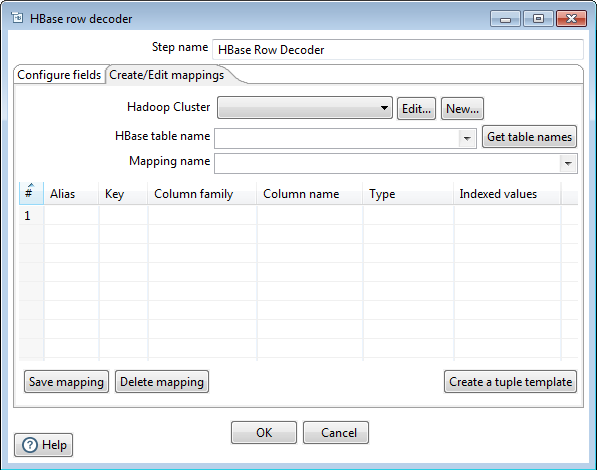HBase Row Decoder
![]() PLEASE NOTE: This documentation applies to an earlier version. For the most recent documentation, visit the Pentaho Enterprise Edition documentation site.
PLEASE NOTE: This documentation applies to an earlier version. For the most recent documentation, visit the Pentaho Enterprise Edition documentation site.
Description
The HBase Row Decoder step decodes an incoming key and HBase result object according to a mapping.
Options
Option | Definition |
|---|---|
Step Name | The name the step as it appears in the transformation workspace. |
Configure Fields Tab
Option | Definition |
|---|---|
Key field | Input key field. |
HBase result field | Field containing the serialized HBase result. |
Create/Edit Mappings Tab
Option | Definition |
|---|---|
HBase table name | Displays a list of table names which have mappings defined for them. |
Mapping name | Names of any mappings that exist for the table. This box will be empty if there are no mappings defined for the selected table. You can define a mapping from scratch or use the connection fields to access any mappings already saved into HBase. |
Save mapping | Saves the mapping in HBase as long as valid connection details were provided and the mapping was named. If the mapping was only needed locally then connection details and mapping name are not needed, the mapping will be serialized into the transformation metadata automatically. |
Delete mapping | Deletes the mapping. |
Create a tuple template | Partially populates the table with special fields that define a tuple mapping for use in the tuple output mode. Tuple output mode allows the step to output all the data in wide HBase rows where the number of columns may vary from row to row. It assumes that all column values are of the same type. A tuple mapping consists of the following output fields: KEY, Family, Column, Value and Timestamp. The type for "Family" and "Timestamp" is preconfigured to "String" and "Long" respectively. You must provide the types for "KEY", "Column" (column name) and "Value" (column value). The default behavior is to output all column values in all column families. |
Metadata Injection Support (7.x and later)
All fields of this step support metadata injection. You can use this step with ETL Metadata Injection to pass metadata to your transformation at runtime.
